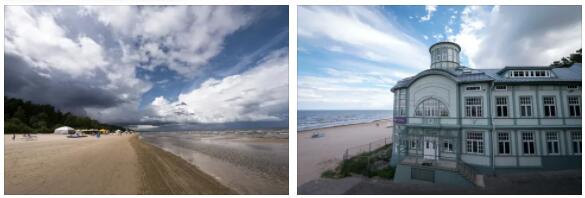Daugavpils (Latvia)
Daugavpils is the second largest city in Latvia. It is located 200 km from Riga on the banks of the Daugava River on the border with Lithuania and Belarus. Its history begins in 1275, when one of the German knights built the Dinaburg fortress here. It was restored in the 19th century. Now it is the only fortress in the entire Baltic that has survived without significant changes. The modern ensemble of the fortress is created by the main fortress (citadel) with buildings in the Empire and classicism styles and a developed defense system located on the right bank of the Daugava, and bridgeheads on the left bank, which served to defend the bridge and the crossing, forming an autonomous defensive system.
In addition to the fortress in the Old Town of Daugavpils there is an Orthodox Cathedral, a Catholic Church, a Lutheran Church and the House of Unity. The facades of the houses here are made of red brick, which are called “Latgale Baroque”.
Liepaja (Latvia)
Liepaja is located in the Kurzeme region in the southern part of the Baltic coast. The first mention of the city dates back to 1253. Today it is both a resort and a major port. Since the beginning of the 20th century, there was a naval port of the Russian Empire on the Baltic Sea. The main attraction of Liepaja is the Orthodox Cathedral of St. Nicholas. It was built in 1900-1903 on the territory of a military port, and Tsar Nicholas II laid the first stone in its foundation. The Church of St. Anna, the oldest in Liepaja, has been preserved in the city, mentions of which date back to 1508. In the church you can see a surprisingly beautiful altar from the end of the 17th century.
There is a lot of vegetation in the city – there is even Rose Square, which has been decorated with numerous rose bushes since 1911. AT Liepaja is the largest park in Latvia – Seaside. The area of the park is more than 50 hectares, more than 140 different types of trees and shrubs grow here. On the Old Embankment of the city it is interesting to walk along the Promenade. Previously, it was a closed area, but now a pleasant and modern place for walking. From the top of the walkway-bridge, you can see the port piers, a fountain, and a large amber clock. The Promenade looks especially colorful at night in the light of lights.
In the northern part of the city is the Karosta district, which means “military port” in translation. One of the oldest bridges in Liepaja is interesting here – the O. Kalpaks Bridge, the Gallery of Modern Art, the Northern Forts (a wide system of fortifications that are gradually washed away into the sea) and the garrison prison, where tourists are invited to participate in a theatrical show. You can feel like a prisoner. All the realities of prison life are observed in the prison – a medical examination, interrogation, a photograph with a number in hand and even a prison ration, if you wish, you can stay in prison for the night.
Jurmala (Latvia)
According to Getzipcodes.org, Jurmala is the largest and most popular resort in Latvia. It is located on the coast of the Gulf of Riga, 20 km from Riga. Sandy beaches stretch for 32 km, all of them meet European standards and all have been awarded the blue flag of the European Union. All beaches of Jurmala are free. The coast here is shallow, so it is suitable for families with children.
Jurmala consists of 12 beach areas, each of which has its own railway station. The main regions are Lielupe and Bulduri. Lielupe is a quiet holiday village with elite cottages and a water park that can accommodate up to 1500 tourists at a time. Locals go to Bulduri for the weekend to rest. The best sanatoriums are located in the areas of Pumpuri, Melluzhi, Vaivari, Jaunkemeri.
Healing air, saturated with the aromas of the sea and pine trees, is one of the healing factors in itself. In addition, in Jurmala there are unique mineral springs and therapeutic muds, and Ķemeri and Jaunkemeri are known as medical and spa centers with sulfur springs and mud baths. In local balneological centers you will be offered hydrogen sulfide baths that stimulate the regeneration of damaged tissues, have an anti-inflammatory effect, help in the treatment of diseases of the musculoskeletal system, peripheral nervous and female reproductive systems, strengthen bones, joints, normalize heart function; bromine-iodine baths, which are prescribed for diseases of the cardiovascular and nervous systems, musculoskeletal system, digestive organs, skin, endocrine system, gynecological diseases, and are also used for hypothyroidism and pharyngitis; all kinds of procedures – Charcot shower, circular shower, pearl baths.
